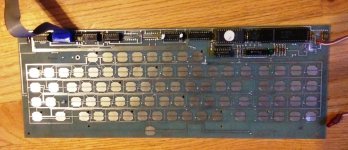misterblack
Fixin' in the basement
So I was working on my (Working) ACE 1000 and I decided to clean the mouse poop off the motherboard. In the process, I removed the ROMs and went to read them all in.... Sadly, in the process, I accidentally wrote to the ROM in G7 before reading it out. One would think it wouldn't do anything, right? Well I did a test with the G8 ROM where I loaded a different ROM and hit write -- it errored out. But then when I loaded the correct ROM into the buffer, I did a verify and the first byte was changed! So I am assuming the first byte of the G7 ROM was changed as well..... and this happened before I read it out and saved it, so I just don't know what it should be.
It is labelled "G7 v2.0 1331404" and is the ROM for E000h.
Does anyone have a copy of the ROM images (specifically of the E0xx v2.0 ROM) I'll need to replace this PROM with a EPROM ......
Also if you have an Ace 1000 with the 2.0 ROM in that socket and you go into machine language monitor, can you show me first few bytes of E000 holds? I can probably hex edit the file I made to make it correct again.
At this point, my machine no longer boots -- just stops at the garbage screen at power-up. It may not be related to the ROMs as the mouse poop has caused some corrosion on some of the other chips and me disturbing those chips might have screwed things up. I may end up trying new chips in those sockets just to see if that helps as they are all normal 74LS logic stuff.
Confirming what E000 ROM has it in would be the best -- but also if you pull the E000 and D800 ROM from the machine I'm curious what that does to the boot sequence. Total stoppage or a crash?
Thanks!
It is labelled "G7 v2.0 1331404" and is the ROM for E000h.
Does anyone have a copy of the ROM images (specifically of the E0xx v2.0 ROM) I'll need to replace this PROM with a EPROM ......
Also if you have an Ace 1000 with the 2.0 ROM in that socket and you go into machine language monitor, can you show me first few bytes of E000 holds? I can probably hex edit the file I made to make it correct again.
At this point, my machine no longer boots -- just stops at the garbage screen at power-up. It may not be related to the ROMs as the mouse poop has caused some corrosion on some of the other chips and me disturbing those chips might have screwed things up. I may end up trying new chips in those sockets just to see if that helps as they are all normal 74LS logic stuff.
Confirming what E000 ROM has it in would be the best -- but also if you pull the E000 and D800 ROM from the machine I'm curious what that does to the boot sequence. Total stoppage or a crash?
Thanks!


